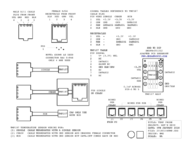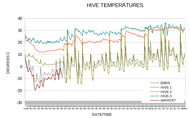Over breakfast with a swimming chum I learned he had several bee hives so I asked if he'd like to monitor the temperature inside them. What could he say, and little did he know what we were getting into.
Around that time I'd been experimenting with a Texas Instruments temperature probe, the TMP107. It was one of those items that popped up in a message from DigiKey. What appealed to me was it used a serial interface and could support cable lengths up to 1000 feet. (Data Sheet p10). Further more it could be daisy chained.
 The original
interface circuit was built atop a RasPi Pro Hat using
dinky wires to attach to the floating SOIC(8) device. Since then
I have learned to mount them onto an adapter with 8 DIP pins.
(SMDPB-051212) I used a 4N35 as the Tx/Rx isolator and a simple
telephone jack as the interconnect.
The original
interface circuit was built atop a RasPi Pro Hat using
dinky wires to attach to the floating SOIC(8) device. Since then
I have learned to mount them onto an adapter with 8 DIP pins.
(SMDPB-051212) I used a 4N35 as the Tx/Rx isolator and a simple
telephone jack as the interconnect.  These
were 'carefully'
installed inside a Betty Crocker sandwhich container with two holes
melted in the sides for power and 'phone'. The box was then
screwed to the inside barn wall closest to the hives and near enough to
power. The first set of hives is about 18ft away so we ran a 25ft
line with a second Betty Crocker screwed to the cluster and acting as a
serial hub. From the hub we ran individual lines to each hive
with a sensor sealed at the far end.
These
were 'carefully'
installed inside a Betty Crocker sandwhich container with two holes
melted in the sides for power and 'phone'. The box was then
screwed to the inside barn wall closest to the hives and near enough to
power. The first set of hives is about 18ft away so we ran a 25ft
line with a second Betty Crocker screwed to the cluster and acting as a
serial hub. From the hub we ran individual lines to each hive
with a sensor sealed at the far end.The software is written in 'C' and takes a sample every hour or so. These are collected in a log file which it attempts to e-mail at midnight. Not much chance of this in the barn but we were able to plug in a laptop and download the files. This can be pretty bone-chilling at -20C as you can see on the chart. My 2108 upgrade will use a Pi Zero W from which we hope to download the data to our 'Androids' in passing. i.e. when BotSync sees the Access Point ( and the boys at Cypress have sorted out the WiFi mess)

The chart shows five temperature records, there are three hive sensors and one sensor inside the Betty Crocker with the Pi-B. The fifth reading is the temperature at Ottawa Airport recorded by Environment Canada. This was just included as a check. The -20C was recorded on the 10th of March and note how one of the hives is at +20C. At the same time one of the hives looked like it had already died and another was struggling, but managed to join the third up in the 30s by early April. I really shouldn't make any further comments but there's likely some gems of wisdom to be gleaned from such observations.